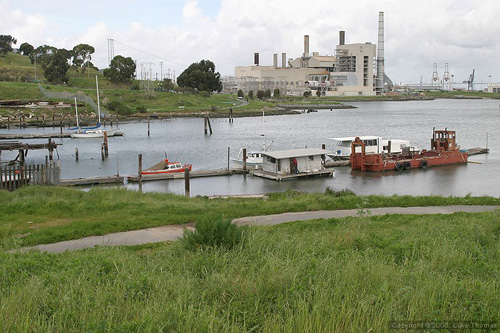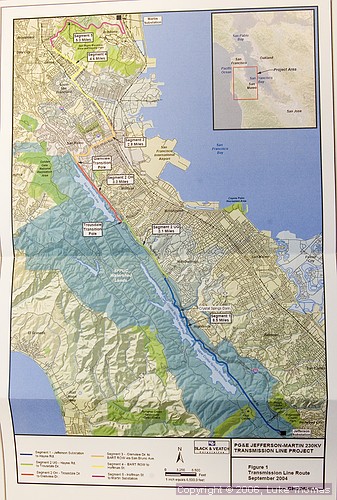Hunters Point celebrates power plant closure Monday
New PG&E transmission line increases power
load
and power reliability

New Jefferson-Martin power transmission line
finalizes Hunter's Point power plant closure.
Photo(s) by
Luke Thomas
By Pat Murphy
May 12, 2006
The long maligned Hunters Point Power Plant goes dark Monday
as PG&E officials turn the switch that shuts it down.
Closure was a long time in the making.
For years, neighborhood activists leveled charges that plant
air pollution contributed to soaring rates of asthma in the Bayview-Hunters
Point district.
And heavily regulated PG&E was more than eager to jump through
years-long hoops necessary to close the facility, PG&E staff
involved in the process told the Sentinel yesterday.
It had reached the end of its useful life but the regulatory
process took from 1999 until 11 o'clock bright Monday morning,
recalled Kevin Dasso.
Dasso serves as senior director of PG&E's asset investment
planning division.

Kevin Dasso (left) and Alain Billot
A stakeholder group was formed in 1999 to meet requirements of
the California Independent System Operator (ISO) as a prelude
to shut down.
"It included various City departments as well as merchant
generators," said Dasso.
"We had all kinds of players that were interested in the
reliable electric service to San Francisco."
Final result of that stakeholder planning process opened as the
Jefferson-Martin transmission line on April 26 this year, delivering
almost twice the power with promise of increased reliability over
the Hunters Point Power Plant.
The new line runs 27 miles into San Mateo County, with three
miles overhead and the remaining 24 miles underground. It is the
largest 230kV underground power project in the United States to
date.
The line starts just north of Woodside, runs through San Mateo
County roads, the Town of Hillsborough, the Cities of Burlingame,
San Bruno, South San Francisco, Colma, Daly City, and ends in
Brisbane.
It delivers 4000 megawatts. Each 1000 megawatts carry electricity
sufficient to power 800 households.

Expanding reliability was at the heart of early planning.
"During those times, it seems like such a long time ago,
but that was really at the height of the dot.com expansion and
we were seeing load growth rates in San Francisco and northern
San Mateo County probably at three or four times we see today,"
Dasso continued.
"We were looking at how to go about meeting the long-term
transmission needs for the area.
"There was an agreement in place at the time to close Hunters
Point Power Plant. Hunters Point was an aging power plant.
"Even if we didn't have the agreement to close the plant
it was reaching near the end of its life and we needed to figure
out what to do about it."
"The San Francisco peninsula for many years, actually since
electric service began, has been served by lines that come up
the peninsula," noted Dasso.
"All that transmission comes from a single substation in
the San Mateo area.
"One of the goals of this longer term San Francisco study
group was to look for alternative feeds so that we have multiple
sources resulting in improved reliability for the whole peninsula.
"About a year-and-a-half into that process we identified
the preference for the project which ultimately became known as
the Jefferson-Martin project."
Other routes were considered before consensus chose the Jefferson-Martin
project, said Alain Billot.
Billot acts as principal project manager for PG&E's San Francisco
reliability department.
"We had looked at other alternatives such as coming from
the East Bay and crossing the Bay in a submarine configuration
or through the BART tunnel. Or a second line from San Mateo,"
stated Billot.
"This (Jefferson-Martin) alternative was definitely the
winner."
It was proposed to the ISO which granted initial approval in
2002.
Next came environmental impact studies.
"What happens is PG&E prepares a Proponent Environmental
Assessment (PEA) and that's an environmental study of alternative
routes and what we think is best from a biological and community
environmental and economic standpoint," Billot explained.
"Once that is prepared then it's turned over to the California
Public Utilities Commission (CPUC) and the CPUC has their environmental
consultants prepare an Environmental Impact Report (EIR).
"That pretty much kick-starts the California Environmental
Quality Act process (CEQA) process."
A Certificate of Public Convenience and Necessity was required
to be issued by the CPUC, due to size of the project, which followed
CPUC assurance CEQA provisions are met.
Public hearings and an evidentiary hearing began drawing input
of the public as well as Federal, State and City agencies participation.
Eight public hearings were held and 12 public agencies or cities
participated in the evidentiary hearing. Initially scheduled as
a five-day hearing, the hearing went on for five weeks.
By 2004, the project was approved to proceed but it took more
than simply building the Jefferson-Martin line.
"At peak, approximately 400 workers were on site with 30
environmental and biological monitors watching the five construction
operations on the Peninsula streets and in the San Francisco Watershed"
when construction finally began, reported Billot.
Several other projects were required in addition to the Jefferson-Martin
project to allow for the closure of Hunters Point. These projects
included upgrading transmission line conductor capacity, installation
of the Potrero Static Compensator, San Mateo-Martin No 4 Line
conversion, installation of a new Ravenswood transformer, San
Francisco internal cable higher emergency rating, Telsa-Newark
No. 2 Line reconductoring, Ravenswood-Ames line reinforcement,
and San Mateo bus insulator replacement.
For the Jefferson-Martin alone, Billot estimated PG&E staff
and consultants preparation costs at $12.5 million, and a forecast
at completion of $218 million.
"It took close to one million hours to install the duct
bank and pull and splice the cable with less that a handful of
minor accident and virtually zero community complaints,"
added Billot.
The effort and investment culminates Monday as all involved kiss
the Hunters Point Power Plant goodbye with happy a flick of a
switch.
####
|